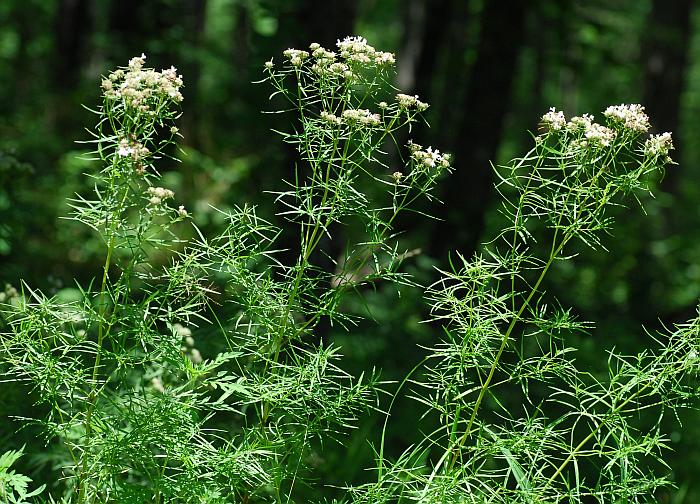Pycnanthemum tenuifolium Schrad.
Slender Mountain Mint

Native
CC = 4
CW = 0
MOC = 89
© SRTurner
Pycnanthemum tenuifolium Schrad.Slender Mountain Mint | |
 |
Native CC = 4 CW = 0 MOC = 89 |
© SRTurner |
|
Family - Lamiaceae Habit - Perennial forb with slender rhizomes. Stem - Strongly ascending to erect, to 80 cm, usually glabrous.
Leaves - Opposite, sessile, simple. Blades 1.5-5.5 cm long, 1.0-5.5 mm wide (those of the largest leaves 1.5-5.5 mm), linear, angled or short-tapered at the base, the margins entire, the surfaces glabrous, green.
Inflorescence - Inflorescences relatively dense, often appearing relatively flat-topped, only the lowermost branches observable. Bracts dissimilar to the foliage leaves (2.5-4.0 mm long, lanceolate to narrowly ovate, with a thickened midvein and a nearly spinescent tip), not whitened, but grayish green, densely pubescent with short, curled hairs on the surfaces and longer, bristly hairs on the margins and tip. Bractlets 2-3 mm long, mostly lanceolate.
Flowers - Calyces 3.5-5.0 mm long, actinomorphic or nearly so, densely or occasionally sparsely pubescent with short, curled hairs below the lobes, lacking longer bristly hairs on the margins, the lobes all similar in size and shape 1.0-1.5 mm long, triangular, sharply pointed and sometimes with a minute, sharply pointed extension of the midnerve. Corollas strongly zygomorphic, 5-7 mm long, white or less commonly pale lavender, the upper lip entire or shallowly notched, the lower lip 3-lobed, spotted with purple.
Fruits - Dry schizocarps, separating into 4 nutlets, these 0.7-1.0 mm long, usually glabrous. Flowering - June - September. Habitat - Forests, glades, prairies, bluffs, pastures, fields, roadsides. Origin - Native to the U.S. Lookalikes - Other members of the Pycnanthemum genus, also some members of the Eupatorium genus such as E. hyssopifolium. Other info. - This plant is common across all of Missouri with the possible exception of a few counties in the extreme northwest of the state. Its U.S. distribution includes most of the eastern half of the country. The plant is easy to recognize with its characteristic inflorescences and very narrow leaves - but note that the main stem leaves can sometimes appear abnormally wide. With respect to the "mountain mint" common name, this plant is a bit of a letdown, since it has almost no minty fragrance. The relative lack of scent is actually a strong clue to the plant's specific identity, since the other Missouri species of Pycnanthemum are more strongly aromatic. The plant is found across a wide variety of habitat types. Photographs taken at Shaw Nature Reserve, Franklin County, MO, 6-15-2007, Whetstone Conservation Area, Callaway County, MO, 7-15-2016, and Western Star Flatwoods, Phelps County, MO, 6-23-2023 (SRTurner). |